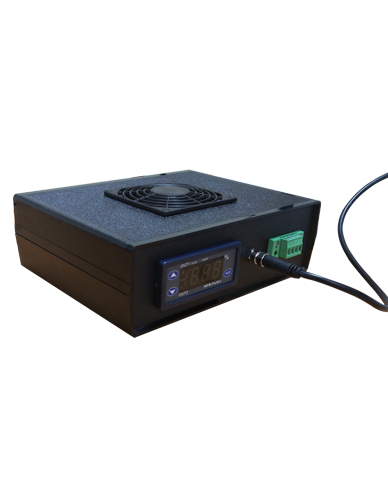The system of hygrometric regulation of the exhibition spaces by electrolysis

An article has just been published in Monumental magazine highlighting the effectiveness of the electrolysis humidity control system for exhibition spaces.
For over 10 years Promuseum has been integrating this ionization air treatment system in its heritage display cases. The joint development of the display cases by Promuseum and MaFabrique's hygrometric control system has enabled museums to offer heritage display cases that meet the highest requirements in terms of preventive conservation.
In his article, Mr. Mohamed Dallel, research engineer at the Research Laboratory of Historical Monuments (LRMH) demonstrates the effectiveness of the Fluxor system through ten years of experience.
The technical principle
For an active regulation of the patrimonial windows, this system of hygrometric control by membrane offers an alternative to the traditional systems with water tank.
It also offers many advantages:
- No maintenance
- No vibration or noise pollution
- A slow and precise regulation for a perfect protection of the collections
For the system to work, the display cases must be specially designed and thought out for its good integration with, in particular, an airtightness of less than or equal to 0.3 volume of air/day, or even 0.1 for the most fragile collections that do not emit VOCs.
Why is the hygrometric regulation of the exhibition spaces essential?
Controlling what we call the climate is essential for the conservation of works of art.
Temperature, air humidity, atmospheric pressure, but also light and air pollution are all factors that can disturb the conservation of works of art and thus alter their longevity.
A good conservation requires the maintenance of a climatic environment as constant as possible by avoiding sudden fluctuations, much more dangerous than slow variations of the same amplitude.
What are the undesirable effects caused by humidity?
A relative humidity of less than 40% causes the organic materials of the documents (paper, parchment, leather, glue) to dry out. They become brittle and stiff. If the dryness lasts, the damage is irreversible. High relative humidity, above 60%, causes swelling of materials, softening of glues (and thus loss of their adhesive power).
In addition, high humidity (even if the temperature is low) favors the development of mold (and possibly insects) in the places where collections are stored.
Experimentation demonstrates the effectiveness of the electrolysis system
In his article, M. Dallel returns to an experimental work site organized by the LRMH which demonstrated the certain effectiveness of the hygrometric regulation by electrolysis membranes. The showcase of the reliquary of Saint-Caprais (Saint-Vrain, Essonne) was the first site followed by the LRMH to be equipped with this technology.
The interior of the Saint-Caprais showcase had a Relative Humidity rate of 70% on average, with peaks of 85%.
Historical monuments suffer mostly from a very unstable hygrometry.
It was therefore decided by the DRAC Ile-de-France and MaFabrique to install a Fluxor® membrane regulator to maintain the humidity between 59% and 64%. After a period of 11 months, the data were analyzed and they are remarkable: the Relative Humidity outside the showcase varied a lot: between 41% and 89%, with an average of 70%; while inside, it stabilized at 60%.
Mr. Dallel concludes: "After ten years of experience and the positive results of this first project, the value of using membranes to regulate the climate of shop windows has been proven. Its advantages, including simplicity, autonomy and high efficiency, rival its cost. "
Other examples of achievements
Promuseum has equipped numerous exhibition spaces with this electrolytic humidity control system.
The system will soon be deployed in Cuffy for the protection of a restored work under the supervision of the DRAC Centre - Val de Loire and in Aire sur Adour for the DRAC Nouvelle-Aquitaine.
Source: Revue Monumental, Editions du Patrimoine - 2nd semester 2020


